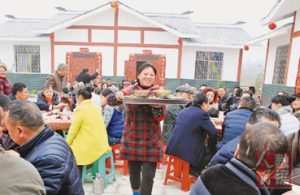人民日报记者 胡泽曦
美国总统特朗普2月27日在白宫会见中国国务委员杨洁篪。杨洁篪表示,中方愿同美方按照两国元首通话精神,秉持不冲突不对抗、相互尊重、合作共赢原则,加强高层及各级别交往,拓展广泛双边领域和重大国际地区问题上的协调与合作,尊重彼此核心利益和重大关切,推动中美关系健康稳定向前发展,更好造福两国人民和世界人民。
特朗普表示,我很高兴同习近平主席进行了十分重要的通话。美方非常重视同中方的合作关系,双方需要加强高层交往,密切各领域合作,增进国际地区事务中协调和合作。
美国副总统彭斯、总统高级顾问库什纳参加会见。同日,杨洁篪还会见美国总统高级顾问库什纳、白宫首席战略师班农、总统国家安全事务助理麦克马斯特等美国高级官员,就进一步发展中美关系和其他共同关心的问题交换了意见。
28日的《人民日报》刊登了杨洁篪的署名文章《坚持<上海公报>原则,推动中美关系健康稳定发展——纪念中美<上海公报>发表45周年》。今年2月28日是中美《上海公报》发表45周年。1972年2月,尼克松总统访华和中美《上海公报》的发表,打破了两国之间的长期对立和隔绝,开启了中美关系正常化的大门。
杨洁篪在文章中指出,《上海公报》确立了中美关系的基本指导原则,包括一个中国、相互尊重、平等互利、和平共处、互不干涉内政等。台湾问题一直是中美关系中最重要最敏感的核心问题。中美建交以来,美国两党历届政府均恪守一个中国政策和中美三个联合公报原则。
“中美合作,对两国和世界都是好事;中美对抗,对两国和世界都是灾难。”“双方应按照习近平主席同特朗普总统通话的精神,加强沟通,增进互信,聚焦合作,管控分歧,实现不冲突不对抗、相互尊重、合作共赢,推动新时期中美关系取得更大发展。”杨洁篪在文章中写道。
2月1日,美国总统特朗普长女伊万卡携女儿前往中国大使馆参加“欢乐春节–中国之夜”活动。人民日报记者 陈丽丹 摄
Chinese senior official pledges closer cooperation with U.S. on global affairs
By Hu Zexi from People’s Daily
China is willing to enhance exchanges with the U.S. at all levels from top down, expand coordination and cooperation on bilateral, regional and global affairs, and respect each others’ core interests and major concerns, Chinese State Councilor Yang Jiechi pledged when meeting with U.S. President Donald Trump at White House.
The exchanges will be based on the spirit of the phone conversation between the two heads of state and principles of non-conflict, non-confrontation, mutual respect and win-win cooperation, the top diplomat added in their Monday meeting.
“A steady and healthy development of the China-U.S. ties will surely benefit both peoples and the world as a whole,” he stressed.
Trump, on his part, said that he was very happy to hold the very important phone conversation with his counterpart Xi Jinping.
Stressing the great importance the U.S. attaches to its cooperation with China, he highlighted the need to bolster high-level exchanges, beef up all-round cooperation, and increase coordination and cooperation on global and regional affairs.
U.S. Vice President Mike Pence and Senior Advisor to the President Jared Kushner, was present at the meeting.
On the same day, Yang also exchanged views on how to further develop bilateral ties and other issues of common concern with Kushner, White House chief strategist Steve Bannon, National Security Advisor Herbert Raymond McMaster and other senior U.S. officials.
Yang also published an article on Tuesday on People’s Daily to honor the 45th anniversary of the signing of the Shanghai Communiqué, a document ended 23 years of diplomatic estrangement and confrontation between China and the U.S.
Yang called for a healthy and steady development of bilateral ties based on the communiqué spirit. The communiqué clarified the basic guidelines for China-U.S. ties, including one-China policy, mutual respect, equality and mutual benefit, peaceful coexistence, and non-interference in the internal affairs of each other.
The Taiwan issue has been a sensitive issue for the bilateral ties, he stressed, adding that since China and the U.S. established their diplomatic ties, the one-China policy and the principles written in their three communiqué, namely the Shanghai Communiqué, Joint Communiqué on the Establishment of Diplomatic Relations and the August 17 communiqué, is a bipartisan consensus in U.S.
“China-U.S. cooperation will bring achievement that is beneficial to both countries and the world, while confrontation will surely spell disaster for the two sides and the whole world,” Yang wrote in the article.











